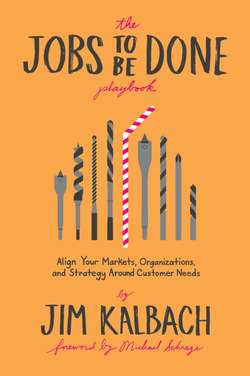Читать книгу The Jobs To Be Done Playbook - Jim Kalbach - Страница 36
На сайте Литреса книга снята с продажи.
Recap
ОглавлениеJTBD gives companies a consistent way to understand the goals and needs that customers have and then bring that insight back into the organization. It focuses on what motivates them to act: they are striving to get a job done. Think of JTBD as a type of language for teams to consistently discover and describe the goals and needs of people.
At the core of the JTBD model are five separate elements, addressing the who, what, how, why, and when/where questions of your field of inquiry:
• Job Performer (who): The person who will be executing the job
• Jobs (what): Includes a main job, related jobs, and emotional jobs and social jobs
• Process (how): A chronological representation of the stages in getting a job done
• Needs (why): The desired outcomes an individual has from performing a job
• Circumstances (when/where): The conditions that frame how the job gets executed
Goals are hierarchical. Through a process of laddering, you can roll up objectives to different levels. The goal at one level may be a stage for the next. In JTBD, there are four levels to consider:
• Aspirations: An ideal change of state, something the individual desires to become
• Big Job: A broader objective, typically at the level of a main job
• Little Job: A smaller job that corresponds roughly to stages in a big job
• Micro-Job: Activities that resemble tasks, but are formulated in terms of JTBD
Getting the right level of abstraction is critical. Ask “why?” to move up in the JTBD hierarchy and ask “how?” to move down.
Start your JTBD research and analysis defining the main job and job performer. Also, create a hypothesis of the job process and circumstances to be validated with research. Talk to a few people upfront for some initial insight into your overall scoping effort.
LEARN MORE
Bob Moesta, “Bob Moesta on Jobs-to-be-Done,” interview by Des Traynor, Inside Intercom. (podcast), May 12, 2016, https://www.intercom.com/blog/podcasts/podcast-bob-moesta-on-jobs-to-be-done/
Moesta is a pioneer in JTBD and directly influenced by Clayton Christensen. In this interview with Des Traynor, co-founder of Intercom and thought leader in JTBD, he covers a range of topics. Overall, it’s a good resource to understand some of the fundamentals of JTBD thinking in general.
Anthony W. Ulwick, “Turn Customer Input into Innovation,” Harvard Business Review (January 2002).
This article was my introduction to JTBD and directly influenced my model outlined in this chapter. Ulwick essentially gives away his secrete sauce for identifying real business opportunities through needs analysis. It starts with not only a deep and thorough understanding of customer jobs, but also a consistent way of representing and working with them.
Anthony W. Ulwick and Lance A. Bettencourt, “Giving Customers a Fair Hearing,” MIT Sloan Management Review (Spring 2008).
This article details a consistent way of expressing goals and needs, largely mirrored here. The language they provide is key for working with jobs and being able to scale them across an organization.
